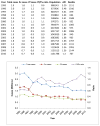Malaria in India: the center for the study of complex malaria in India
- PMID: 22142788
- PMCID: PMC3294179
- DOI: 10.1016/j.actatropica.2011.11.008
Malaria in India: the center for the study of complex malaria in India
Abstract
Malaria is a major public health problem in India and one which contributes significantly to the overall malaria burden in Southeast Asia. The National Vector Borne Disease Control Program of India reported ∼1.6 million cases and ∼1100 malaria deaths in 2009. Some experts argue that this is a serious underestimation and that the actual number of malaria cases per year is likely between 9 and 50 times greater, with an approximate 13-fold underestimation of malaria-related mortality. The difficulty in making these estimations is further exacerbated by (i) highly variable malaria eco-epidemiological profiles, (ii) the transmission and overlap of multiple Plasmodium species and Anopheles vectors, (iii) increasing antimalarial drug resistance and insecticide resistance, and (iv) the impact of climate change on each of these variables. Simply stated, the burden of malaria in India is complex. Here we describe plans for a Center for the Study of Complex Malaria in India (CSCMi), one of ten International Centers of Excellence in Malaria Research (ICEMRs) located in malarious regions of the world recently funded by the National Institute of Allergy and Infectious Diseases, National Institutes of Health. The CSCMi is a close partnership between Indian and United States scientists, and aims to address major gaps in our understanding of the complexity of malaria in India, including changing patterns of epidemiology, vector biology and control, drug resistance, and parasite genomics. We hope that such a multidisciplinary approach that integrates clinical and field studies with laboratory, molecular, and genomic methods will provide a powerful combination for malaria control and prevention in India.
Copyright © 2011 Elsevier B.V. All rights reserved.
Figures


Similar articles
-
Malaria in selected non-Amazonian countries of Latin America.Acta Trop. 2012 Mar;121(3):303-14. doi: 10.1016/j.actatropica.2011.06.008. Epub 2011 Jul 1. Acta Trop. 2012. PMID: 21741349 Free PMC article.
-
Malaria evolution in South Asia: knowledge for control and elimination.Acta Trop. 2012 Mar;121(3):256-66. doi: 10.1016/j.actatropica.2012.01.008. Epub 2012 Jan 14. Acta Trop. 2012. PMID: 22266213 Free PMC article. Review.
-
Prospects for malaria elimination in non-Amazonian regions of Latin America.Acta Trop. 2012 Mar;121(3):315-23. doi: 10.1016/j.actatropica.2011.06.018. Epub 2011 Jul 14. Acta Trop. 2012. PMID: 21781953 Free PMC article.
-
Malaria elimination in India and regional implications.Lancet Infect Dis. 2016 Oct;16(10):e214-e224. doi: 10.1016/S1473-3099(16)30123-2. Epub 2016 Aug 12. Lancet Infect Dis. 2016. PMID: 27527748 Review.
-
Malaria in the Greater Mekong Subregion: heterogeneity and complexity.Acta Trop. 2012 Mar;121(3):227-39. doi: 10.1016/j.actatropica.2011.02.016. Epub 2011 Mar 5. Acta Trop. 2012. PMID: 21382335 Free PMC article. Review.
Cited by
-
Defining symptoms of malaria in India in an era of asymptomatic infections.Malar J. 2020 Jul 6;19(1):237. doi: 10.1186/s12936-020-03310-9. Malar J. 2020. PMID: 32631326 Free PMC article.
-
A micro-epidemiological report on the unstable transmission of malaria in Aligarh, India.Parasite Epidemiol Control. 2020 Jun 27;11:e00161. doi: 10.1016/j.parepi.2020.e00161. eCollection 2020 Nov. Parasite Epidemiol Control. 2020. PMID: 32642569 Free PMC article.
-
Natural selection mediated association of the Duffy (FY) gene polymorphisms with Plasmodium vivax malaria in India.PLoS One. 2012;7(9):e45219. doi: 10.1371/journal.pone.0045219. Epub 2012 Sep 21. PLoS One. 2012. PMID: 23028857 Free PMC article.
-
A district-level susceptibility and vulnerability assessment of the COVID-19 pandemic's footprint in India.Spat Spatiotemporal Epidemiol. 2021 Feb;36:100390. doi: 10.1016/j.sste.2020.100390. Epub 2020 Nov 8. Spat Spatiotemporal Epidemiol. 2021. PMID: 33509422 Free PMC article.
-
The Impact, Emerging Needs, and New Research Questions Arising from 12 Years of the Center for the Study of Complex Malaria in India.Am J Trop Med Hyg. 2022 Oct 11;107(4_Suppl):90-96. doi: 10.4269/ajtmh.21-1277. Print 2022 Oct 11. Am J Trop Med Hyg. 2022. PMID: 36228922 Free PMC article.
References
-
- Adak T, Kaur S, Singh OP. Comparative susceptibility of different members of the Anopheles culicifacies complex to Plasmodium vivax. Trans R Soc Trop Med Hyg. 1999;93(6):573–577. - PubMed
-
- . Rolling back malaria - the next ten years. Lancet. 2008;372:1193. - PubMed
-
- Carlton JM, Adams JH, Silva JC, Bidwell SL, Lorenzi H, Caler E, Crabtree J, Angiuoli SV, Merino EF, Amedeo P, Cheng Q, Coulson RM, Crabb BS, Del Portillo HA, Essien K, Feldblyum TV, Fernandez-Becerra C, Gilson PR, Gueye AH, Guo X, Kang’a S, Kooij TW, Korsinczky M, Meyer EV, Nene V, Paulsen I, White O, Ralph SA, Ren Q, Sargeant TJ, Salzberg SL, Stoeckert CJ, Sullivan SA, Yamamoto MM, Hoffman SL, Wortman JR, Gardner MJ, Galinski MR, Barnwell JW, Fraser-Liggett CM. Comparative genomics of the neglected human malaria parasite Plasmodium vivax. Nature. 2008;455(7214):757–763. - PMC - PubMed
-
- Dash AP, Adak T, Raghavendra K, Singh OP. The biology and control of malaria vectors in India. Curr Sci. 2007;92:1571–1578.
-
- Dash AP, Valecha N, Anvikar AR, Kumar A. Malaria in India: challenges and opportunities. J Biosci. 2008;33(4):583–592. - PubMed
Publication types
MeSH terms
Substances
Grants and funding
LinkOut - more resources
Full Text Sources
Medical
Molecular Biology Databases

